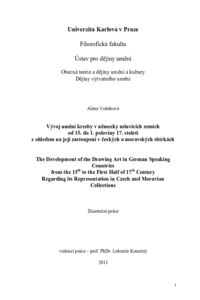Vývoj umění kresby v německy mluvících zemích od 15. do 1. poloviny 17. století s ohledem na její zastoupení v českých a moravských sbírkách
The Development of the Drawing Art in German Speaking Countries from the 15th to the First Half of 17th Century Regarding its Representation in Czech and Moravian Collections
dizertační práce (OBHÁJENO)

Zobrazit/
Trvalý odkaz
http://hdl.handle.net/20.500.11956/45556Identifikátory
SIS: 104602
Kolekce
- Kvalifikační práce [23976]
Autor
Vedoucí práce
Oponent práce
Royt, Jan
Fučíková, Eliška
Fakulta / součást
Filozofická fakulta
Obor
Dějiny výtvarného umění
Katedra / ústav / klinika
Ústav pro dějiny umění
Datum obhajoby
5. 4. 2012
Nakladatel
Univerzita Karlova, Filozofická fakultaJazyk
Čeština
Známka
Prospěl/a
Práce se zabývá vývojem kresby v německy mluvících zemích od počátků 15. století, kdy ještě doznívaly pozdně gotické tradice, dále obdobím manýrismu v 16. století, až do 1. poloviny 17. století, ve kterém již nastupoval barokní umělecký směr. Úvodní kapitola se věnuje stavu dosavadního bádání, jenž se odehrával a stále odehrává zejména mezi německými badateli. V Čechách se mu věnovala ve své kandidátské práci v roce 1969 Eliška Fučíková, po té se tématu dotkl Pavel Preiss, v současné době Lubomír Slavíček. Další kapitola se zabývá technikou kresby v těchto obdobích se zřetelem na perokresbu obvyklou v Německu a následuje shrnutí typických znaků německé kresby, která se většinou vyznačovala oproti soudobé italské kresbě větší uzavřeností a pevností objemu. Část o zastoupení německé kresby v českých sbírkách je věnována jednak provenienci kreseb a z toho vyplývající obsah muzejních sbírek v českých zemích, jenž poměrně dobře zastupuje vývoj sledovaného tématu, ačkoliv zde citelně chybí listy Albrechta Dürera. Základní korpus práce pak sleduje prostřednictvím okruhů vývoj kresby v německy mluvících oblastech ilustrovaný příklady nacházející se ve veřejných sbírkách. Lze se opřít o několik velmi kvalitních listů z 1. poloviny 15. století, dále jsou k dispozici kresby z 2. poloviny 15. století. Tvorbu...
The thesis deals with the development of drawing in German-speaking countries since the early 15 th century, when the late Gothic traditions still echoed, to mannerism in the 16 th and first half of the 17 th centuries, when the Baroque enjoyed its ascent. The introductory chapter is dedicated to the current state of ongoing research, especially in Germany. Eliška Fučíková, in her Candidate of Sciences (CSc.) thesis in 1969, and later Pavel Preiss and today Lubomír Slavíček, have dealt with the subject in Bohemia. The next chapter deals with drawing techniques in the respective periods, with a focus on the pen drawing common in Germany at the time. The chapter that follows summarises the typical characteristics of German drawing, which was usually more confined and firm in volume than the Italian drawing of the time. The section addressing the representation of German drawing in the Czech collections is dedicated to the provenance of the drawings and the resulting repertoire of the museum collections in the Czech Lands. The explored theme is well represented for the most part, despite a painful lack of drawings by Albrecht Dürer. The thesis' main section follows the development of drawing in different art circles in German-speaking regions, illustrating its subject with examples found in public...
